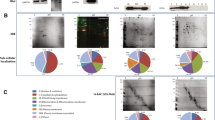Abstract
Free Flow Electrophoresis (FFE) is a liquid-based isoelectric focusing method. Unlike conventional in-gel fractionation of proteins, FFE can resolve proteins in their native forms and fractionation of subcellular compartments of the cell is also possible. To test the efficacy of the FFE method, the native cytosol proteome of a bacterium, Pseudomonas putida KT2440 was fractionated by FFE and the spectrum of protein elutes was characterized in association with 2-dimentional gel electrophoresis (2-DE). Major native proteins of P. putida KT2440 were eluted in the range of pH 4.8∼6.0 in FFE, whereas the denatured proteome of P. putida KT2440 was widely distributed in the rage of pH 4∼10 in the 2-DE analysis. In addition, one of the three FFE major fractions, which was eluted at pH 5.0, was further analyzed using 2-DE/MS-MS. Then, the pH range of identified proteins eluted in 2-DE/MS-MS was 4.72∼5.89, indicating that observed pi values of native cytosolic proteomes in FFE were narrower than those of denatured cytosolic proteome. These results suggest that FFE fractionation and 2-DE/MS analysis may be useful tools for characterization of native proteomes of P. putida KT2440 and comparative analysis between denatured and native proteomes.
Similar content being viewed by others
References
Benndorf, D., M. Thiersch, N. Loffhagen, C. Kunath, and H. Harms. 2006. Pseudomonas putida KT2440 responds specifically to chlorophenoxy herbicides and their initial metabolites. Proteomics 6, 3319–3329.
Braun, R.J., N. Kinkl, M. Beer, and M. Ueffing. 2007. Two-dimensional electrophoresis of membrane proteins. Anal. Bioanal. Chem. 389, 1033–1045.
Cho, S.Y., E.Y. Lee, J.S. Lee, H.Y. Kim, J.M. Park, M.S. Kwon, Y.K. Park, H.J. Lee, M.J. Kang, J.Y. Kim, J.S. Yoo, S.J. Park, J.W. Cho, H.S. Kim, and Y.K. Paik. 2005. Efficient prefractionation of low-abundance proteins in human plasma and construction of a two-dimensional map. Proteomics 5, 3386–3396.
Hoffmann, P., H. Ji, R.L. Moritz, L.M. Connolly, D.F. Frecklington, M.J. Layton, J.S. Eddes, and R.J. Simpson. 2001. Continuous free-flow electrophoresis separation of cytosolic proteins from the human colon carcinoma cell line LIM 1215: A non two-dimensional gel electrophoresis-based proteome analysis strategy. Proteomics 1, 807–818.
Kapatral, V., X. Bina, and A.M. Charkrabarty. 2000. Succinyl coenzyme A synthetase of Pseudomonas aeruginosa with a broad specificity for nucleoside triphosphate (NTP) synthesis modulates specificity for NTP synthesis by the 12-kilodalton form of nucleoside diphosphate kinase. J. Bacteriol. 182, 1333–1339.
Kavanaugh-Black, A., D.M. Connolly, S.A. Chugani, and A.M. Charkrabarty. 1994. Characterization of nucleoside-diphosphate kinase from Pseudomonas aeruginosa: complex formation with succinyl-CoA synthetase. Proc. Natl. Acad. Sci. USA 91, 5883–5887.
Kim, Y.H., K. Cho, S.H. Yun, J.Y. Kim, K.H. Kwon, J.S. Yoo, and S.I. Kim. 2006. Analysis of aromatic catabolic pathways in Pseudomonas putida KT 2440 by combined proteomic approach: 2-DE/MS and cleavable ICAT analysis. Proteomics 6, 1301–1318.
Kurbatov, L., D. Albrecht, H. Herrmann, and L. Petruschka. 2006. Analysis of the proteome of Pseudomonas putida KT2440 grown on different sources of carbon and energy. Environ. Microbiol. 8, 466–478.
Moritz, R.L., A.B. Clippingdale, E.A. Kapp, J.S. Eddes, H. Ji, S. Gilbert, L.M. Connolly, and R.J. Simpson. 2005. Application of 2-D free-flow electrophoresis/RP-HPLC for proteomic analysis of human plasma depleted of multi high-abundance proteins. Proteomics 5, 3402–3413.
Moritz, R.L., H. Ji, F. Schütz, L.M. Connolly, E.A. Kapp, T.P. Speed, and R.J. Simpson. 2004. A proteome strategy for fractionating proteins and peptides using continuous free-flow electrophoresis coupled off-line to reversed-phase high-performance liquid chromatography. Anal. Chem. 76, 4811–4824.
Moritz, R.L. and R.J. Simpson. 2005. Liquid-based free-flow electrophoresis-reversed-phase HPLC: a proteomic tool. Nat. Methods 2, 863–873.
Nelson, K.E., C. Weinel, I.T. Paulsen, R.J. Dodson, H. Hilbert, V.A. Martins dos Santos, D.E. Fouts, S.R. Gill, M. Pop, M. Holmes, L. Brinkac, M. Beanan, R.T. DeBoy, S. Daugherty, J. Kolonay, R. Madupu, W. Nelson, O. White, J. Peterson, H. Khouri, et al. 2002. Complete genome sequence and comparative analysis of the metabolically versatile Pseudomonas putida KT2440. Environ. Microbiol. 4, 799–808.
Park, S.H., J.W. Kim, S.H. Yun, S.H. Leem, H.Y. Kahng, and S.I. Kim. 2006. Characterization of β-ketoadipate pathway from multi-drug resistance bacterium, Acinetobacter baumanni DU202 by proteomic approach. J. Microbiol. 44, 632–640.
Pyndiah, S., J.P. Lasserre, A. Ménard, S. Claverol, V. Prouzet-Mauléon, F. Mégraud, F. Zerbib, and M. Bonneu. 2007. Twodimensional blue native/SDS gel electrophoresis of multiprotein complexes from Helicobacter pylori. Mol. Cell. Proteomics 6, 193–206.
Simpson, R.J. 2004. Purifying proteins for proteomics, p. 463–478. Cold Spring Harbor Laboratory Press, Cold Spring Harbor, New York, N.Y., USA.
Zischka, H., R.J. Braun, E.P. Marantidis, D. Büringer, C. Bornhövd, S.M. Hauck, O. Demmer, C.J. Gloeckner, A.S. Reichert, F. Madeo, and M. Ueffing. 2006. Differential analysis of Saccharomyces cerevisiae mitochondria by free flow electrophoresis. Mol. Cell. Proteomics 5, 2185–2200.
Author information
Authors and Affiliations
Corresponding author
Rights and permissions
About this article
Cite this article
Choi, CW., Hong, Y.S. & Kim, S.I. Application of free-flow electrophoresis/2-dimentional gel electrophoresis for fractionation and characterization of native proteome of Pseudomonas putida KT2440. J Microbiol. 46, 448–455 (2008). https://doi.org/10.1007/s12275-008-0063-9
Received:
Accepted:
Published:
Issue Date:
DOI: https://doi.org/10.1007/s12275-008-0063-9




